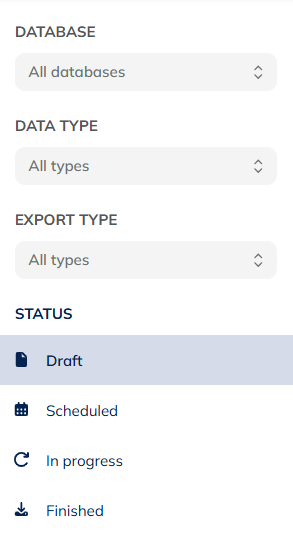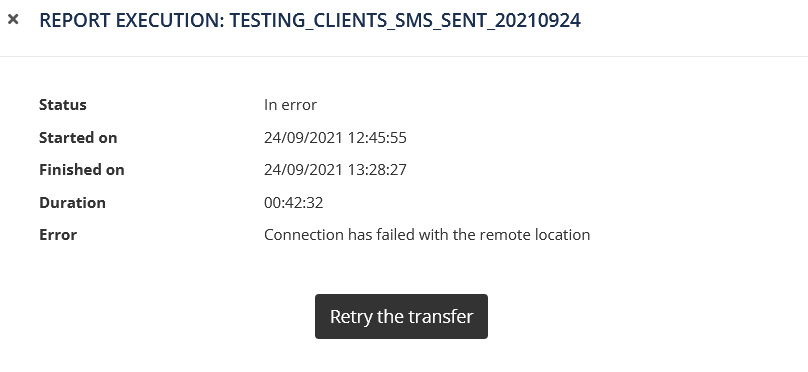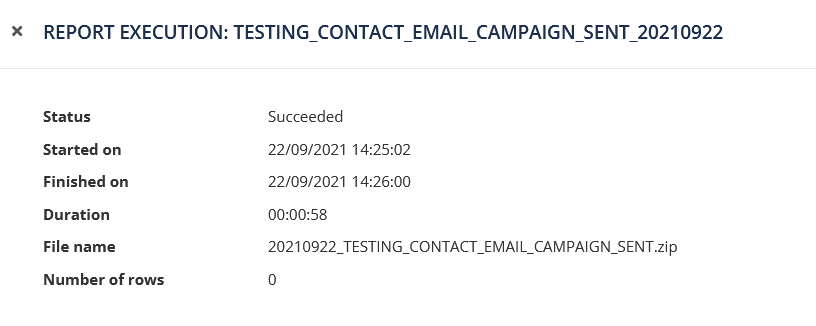Understanding the Exports app
From the Exports module, you can either create a new export or perform a series of actions on already existing exports.
Creating a new export
If you want to create a new export, you just need to click on the "Create export" button.

The instructions to define the format of your export depends on the type and the data of your export.
Finding your export
If you want to perform an action on an already existing export, the first thing that you should do is finding the relevant export. For that, you can search for the export name through the searching bar. You can also use the different options in the left side of the screen to filter the exports:

- The first section allows you to chose the profile table to which your export belongs.
- The section section allows you to choose the relevant data type. The data type can simply be the table type for one-shot exports (profile, linked data, repository and interaction) or more specific for exports related to some precise type of interaction (form participation, subscriptions).
- This section allows you to select the export type. There are five export types: one shot, periodic full, incremental, custom and incremental custom.
- This section allows you to filter the exports by their current status. The actions available to perform on an export will depend on its status.
A one shot export is a simple extract of data from a table at a given time and date.
A periodic full export is a daily extract of a whole (subset of a) table to a third party system. All corresponding lines are exported every day.
An incremental export is a daily extract of new data to a third party system. Only the new lines/events since the previous execution (i.e. yesterday) are exported.
Performing actions on your exports
The actions allowed will mainly depend on the export status.
Editing an export
You can always edit exports in the Draft status, namely exports that are still in definition. To continue editing an export, select the relevant export and click on "Edit". You will be directed to the export creation process.
Ongoing exports such as periodic and incremental exports must first be unscheduled before they can be edited.

Copying an export
You can copy exports from the Draft, Scheduled and Finished tabs.
Select the relevant export and click on "Copy" to create an identical draft. You will be asked to give the export a new name and you will be directed to the export creation process, where you"ll be able to modify all the parameters that you want.

Deleting an export
You can only delete exports that are still in the Draft status.
Go to the "In definition" tab, select the export that you want to delete and click on "Delete". You will be asked to confirm the action.

Viewing the definition of an export
You can always view the definition of Scheduled, Finished or In progress exports.
Select the relevant export and click on "View definition". A summary of the export parameters will appear in a modal window. It will contain the same information as in the last step of the export creation.

Stopping an export
You can stop exports in the Scheduled tab by selecting the relevant export and clicking on the "Stop" button.
Scheduled exports are periodic or incremental (or custom) exports : for these types, the last execution goes in the Finished tab, while the next execution appears in Scheduled.
Stopping exports will effectively stop the export. The whole export is stopped, not just the next execution.

Downloading an export
When a one shot export has finished, it means that it's ready to be downloaded.
Go to the Finished tab, select the export that you want to download and click on "Download". The data extracted will be automatically downloaded to your computer.
Only manual one shot exports can be downloaded via the Exports module. Periodic or incremental (and custom) exports are always sent into the cloud (the transferbox, a FTPS...).

Viewing the report of an export
You can view the report of exports in the Finished tab, which include one shot exports and past executions of periodic/incremental exports.
Select the export and click on "View report".

The report will provide the following information:
- The status (succeeded or failed)
- The start and end time
- The duration
- The file name (including the date pattern) and the number of rows exported if the export is in success
- The error code if the export has failed. Depending on the reason for the failure, you may have the possibility to relaunch the execution of the export directly (for example, connection issue with the cloud location)

